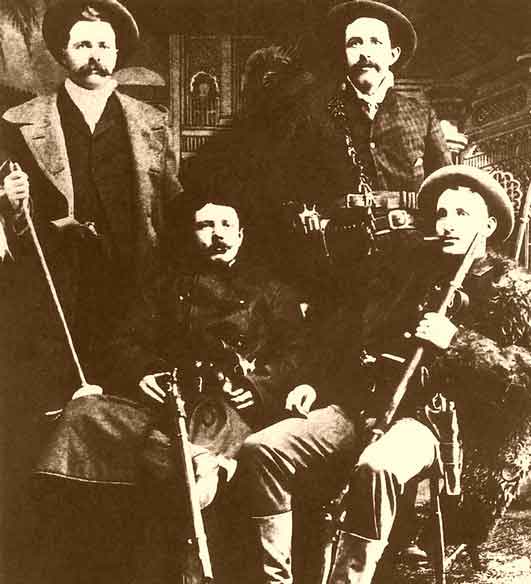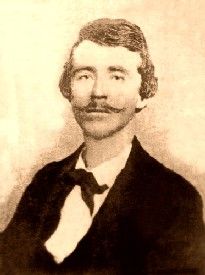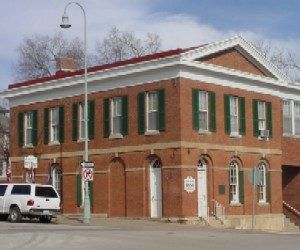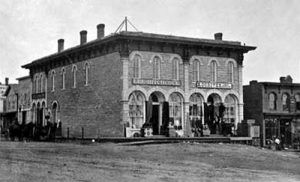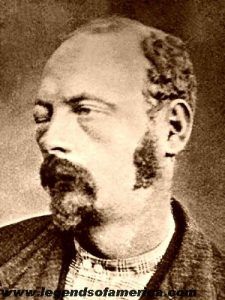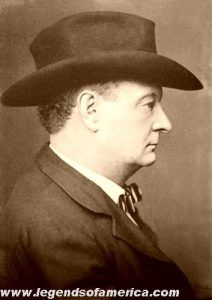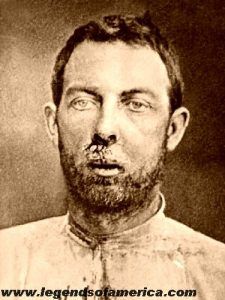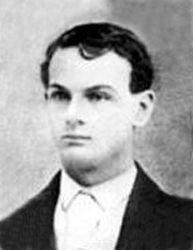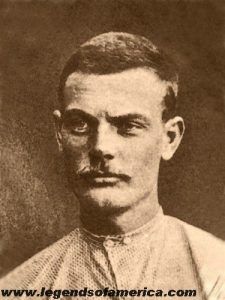The Infamous Younger Brothers – Legends of America (original) (raw)
The James-Younger Gang – Left to right: Cole” Younger, Jesse Woodson James, Bob Younger, and Frank James.
I am a bonded highwayman
Cole Younger is my name Through many a temptation I’ve brought my friends to shame. For the robbing of the Northfield bank
They say I can’t deny
And now I am a poor prisoner In the Stillwater Jail I lie.
— Excerpt from a ballad written by Cotton Davis Woodville, 1941
The infamous Younger Brothers of Jackson County, Missouri, sons of a prosperous slave-owning farmer, would grow up to become some of the most well-known Civil War guerrillas and outlaws in history when they joined up with Frank and Jesse James to form the James-Younger Gang.
The four brothers — Thomas Coleman, James Hardin, John Harrison, and Robert Ewing, were from a large family of 14 children born to Henry Washington and Busheba Fristoe Younger. Henry came to the Kansas City, Missouri area from Kentucky, where he met Busheba Leighton Fristoe, the daughter of a prominent area farmer. The two soon married, settled on a farm and began to have children. Henry was quickly successful in his farming endeavors and began to accumulate quite a bit of land, as well as expanding into business ventures, which included earning a contract as a “mail agent” with the federal government.
The many children of the prosperous Henry Younger were well-educated and lived a good life up until the time that major strife began to break out in the area during what would become known as the Kansas-Missouri Border War. Kansas, established as a “free-state,” was in constant conflict with its neighbor of Missouri, which was primarily populated with slave-owning families. Despite the fact that Henry owned a couple of slaves, he was a Union sympathizer, believing that the Union should be preserved and that slavery should be abolished.
William Quantrill
His beliefs, however, would not stop raids on his farm by Kansas guerillas, which were referred to as “Jayhawkers.” During these raids, his stock and wagons would be stolen and his property destroyed. These actions began to turn his sons against the Union and, more specifically, against the Kansas guerillas. After watching the violence for years, Cole Younger went against his father’s beliefs and sided with the Confederates, becoming a guerilla himself under William Quantrill. When his father was killed by a detachment of Union militiamen in July 1862, Cole’s anger was fired even further against the Union and the Kansas Jayhawkers. On August 21, 1863, he participated in the notorious raid against Lawrence, Kansas, where some 200 men and boys were killed and the town was ransacked and burned.
In 1864, Cole’s brother, James, also joined up with Quantrill’s band, and Cole moved on to serve in the regular Confederate Army. He was soon made captain and led his men into Louisiana and later into California, where he remained until the close of the war. Cole returned to his home in 1865. In the meantime, James had been captured by Union troops in the same ambush that resulted in William Quantrill’s death. He was then sent to Alton prison until the end of the war.
Cole and James returned to the family farm to find it in ruins and the once profitable business long gone. Though brothers John and Bob had done their best to maintain the farm, the ravages of war had taken their toll.
The first bank to be robbed by the James-Younger Gang was in Liberty, Missouri, on February 13, 1866, by Kathy Alexander.
An embittered Cole continued to associate with his old war comrades, and in the midst of the tumultuous Reconstruction in Missouri, some former soldiers turned outlaws. Claiming to be taking revenge against Yankee capitalist banks and railroads, the James-Younger Gang made its first robbery on February 13, 1866, when the men stormed the Clay County Savings Association in Liberty, Missouri, taking over $60,000 in cash and bonds.
For the next several years, the gang, which included such notorious men as Jesse and Frank James, Clell Miller, Bill Chadwell, and Charlie Pitts, also added James, John, and Bob Younger to their ranks. The large, loosely organized group of former guerrillas carried out robberies and hold-ups throughout the South and Midwest. The Younger brothers took part in an estimated 12 bank robberies, seven train robbers, and four stagecoach robberies, leaving behind at least 11 dead citizens.
In the meantime, in March 1874, Jim and John were involved in a shoot-out near Roscoe, Missouri, with Pinkerton Agents. When the smoke cleared, John Younger, St. Clair County Deputy Edwin Daniels, and Pinkerton Agent Louis J. Lull were killed, but Jim managed to escape.
However, it was the attempted robbery in Northfield, Minnesota, would spell the death of the James-Younger Gang, though a later gang would be formed simply called the James Gang.
After taking the train to Minneapolis in early September 1876, the group split up, with one party going to Mankato and the other to Red Wing, on either side of Northfield. After scouting the area, they attempted to rob the bank on September 7, 1876. Jesse and Frank James, along with Bob Younger, went inside the bank while Cole and Jim Younger, Bill Chadwell, Clell Miller, and Charlie Pitts stood guard outside.
Northfield, Minnesota Bank
Inside the bank, the three outlaws demanded that the vault be opened and the money surrendered. However, Joseph Lee Heywood, the bank clerk on duty, refused to do so and was shot and killed. Hearing shots, Northfield citizens realized that a robbery was in progress, and taking up arms, they began to shoot at those outside, killing Miller and Chadwell and hitting Cole Younger in the thigh. In the meantime, Jesse, Frank, and Bob Younger fled from the bank, and Bob was shot in the right elbow. Returning the fire, the gang killed Nicholas Gustavson, a Swedish man who was caught in the crossfire.
The surviving gang members then took off and were quickly pursued by posses. Near Mankato, the gang split up with the Younger brothers and Charlie Pitts going one way and the James brothers going another. After covering some 400 miles in the search for the outlaws, the posse caught up with the Youngers near Madelia, Minnesota, on September 21, 1876, and after a gunfight erupted, Charlie Pitts was killed and the Younger brothers further wounded. Finally, they surrendered. Tried in Faribault, Minnesota, they were found guilty of murder and sentenced to 25 years in the state prison at Stillwater. Bob Younger died in prison in 1889; Jim was paroled in 1901 but committed suicide the following year; and Cole, who was paroled in 1901 and pardoned in 1903, lived until 1916.
The Younger Brothers
Cole Younger after having been injured during his capture after the Northfield, Minnesota raid.
Thomas Coleman “Cole” Younger (1844-1916) – Confederate guerrilla and one of the leaders of the James-Younger Gang, Cole Younger was born on January 15, 1844, the seventh of 14 children of Henry Washington and Bersheba Leighton Fristoe Younger. Despite his father’s support of the Union, Cole supported pro-slavery Missouri after struggles began between Kansas and Missouri prior to the Civil War. He joined William Quantrill’s guerrillas in 1861 and took part in the Lawrence, Kansas raid on August 21, 1863, which left some 200 men and boys dead and the city ransacked and burned.
In 1864, he moved on to serve in the regular Confederate Army. He was soon made captain and led his men into Louisiana and later into California, where he remained until the close of the war. Cole returned to his home in 1865 to find the family farm in ruins.
An embittered Cole continued to associate with his old war comrades, and in the midst of the tumultuous Reconstruction in Missouri, some former soldiers, including Cole Younger, turned outlaw.
Claiming to be taking revenge against Yankee capitalist banks and railroads, the James-Younger Gang made its first robbery on February 13, 1866, when the men stormed the Clay County Savings Association in Liberty, Missouri, taking over $60,000 in cash and bonds.
Taking a leadership role in the James-Younger Gang, he participated in a number of bank, train, and stagecoach robberies over the next several years, though he would insist until the end of his life that he never robbed a bank in Missouri.
Following the attempted Northfield, Minnesota bank robbery on September 7, 1876, which netted the gang nothing and resulted in gunplay with local citizens. Gang members Clell Miller and Bill Chadwell, were killed, and Bob Younger was badly wounded in the elbow. Also killed were two townspeople, including the bank cashier, before the gang fled empty-handed.
Thomas Coleman Younger in his later years.
Near Mankato, the gang split up with the Younger brothers and Charlie Pitts going one way and the James brothers another. Though Frank and Jesse safely returned to Missouri, the Youngers were not so fortunate. When a posse caught up with the four men near Madelia, Minnesota, on September 21, 1876, a gunfight erupted, in which Charlie Pitts was killed and the Younger brothers wounded. Finally, they surrendered. Tried in Faribault, Minnesota, they were found guilty of murder and sentenced to 25 years in the state prison at Stillwater.
After serving more than twenty years in prison, Cole was paroled in 1901 but was not allowed to leave the State of Minnesota. Cole, along with brother Jim, sold tombstones and insurance for a time. Cole received an official pardon in 1903 and returned home to Lee’s Summit, Missouri. Cole reunited with Frank James in a touring Wild West show for a time and also went on the lecture circuit preaching the evils of crime. In 1903, he published a brief autobiography entitled The Story of Cole Younger, in which he portrayed himself as a Confederate avenger rather than an outlaw. In his last years, he declared that he had become a Christian and was known as an elderly churchgoer in his hometown. He died quietly on March 21, 1916, and is buried in the Lee’s Summit Historical Cemetery.
James “Jim” Hardin Younger (1848-1902) – Jim was born to Henry Washington Younger and Bersheba Leighton Fristoe Younger on January 15, 1848, in Harrisonville, Missouri. He was described as quiet and well-mannered and more of a listener than a talker. He grew up to follow in Cole’s footsteps and joined Quantrill’s Confederate band of bushwhackers. He was later captured by Union troops in the same ambush that resulted in William Quantrill’s death. He was then sent to Alton prison until the end of the war. Afterward, he tried his hand at a number of jobs, including starting a horse ranch and serving as a deputy sheriff in Dallas County, Texas, in 1870-71. Two years later, he joined the James-Younger Gang and participated in the train robbery in Adair, Iowa, in July 1873.
Jim Younger committed suicide while on parole in Minnesota after
serving 25 years in prison for the Northfield raid.
The following year, in March, Jim and his brother, John, were headed to Roscoe, Missouri, when they were approached by several men asking for directions. Suspecting that they were law officers, a shootout began, and John was shot through the neck and died.
Also killed were St. Clair County Deputy Edwin Daniels and Pinkerton Agent Louis J. Lull. Jim managed to escape. After the death of his brother, he left the gang and spent the next two years working a ranch in San Luis Obispo, California.
Jim returned to the gang in time to join the ill-fated 1876 bank job in Northfield, Minnesota. Part of his jaw was shot off, and he was captured and sentenced to life imprisonment. He was paroled in 1901 with his brother Cole. Jim fell in love with a newspaper writer, Alice Miller, but was not permitted to marry under the strict parole terms handed down by the state. Despondent, he killed himself on October 19, 1902. His body was returned to his home, where he is buried in the Lee Summit Historical Cemetery in Missouri.
John Harrison Younger (1851-1874) – The younger brother of Cole and Jim Younger, John was the 11th of 14 children born in the Younger clan. When brothers Cole and Jim joined William Quantrill’s Guerillas during the Civil War, John and his brother, Bob, were too young and stayed home to look after their mother and sisters.
After the war was over, when John and Bob drove their mother into Independence, Missouri, for supplies in January 1866, a soldier recognized the family and began to make rude comments about Cole. When 15-year-old John told him to be quiet, the soldier slapped him on the face with a frozen fish, at which point John pulled out a revolver and shot him between the eyes. After the dead soldier’s body was examined, it revealed a slingshot, so the killing was ruled as self-defense.
John Younger
Soon after, the Younger family headed to Texas until mother Bersheba became ill, and the Younger brothers, with the exception of Cole, took her back to Missouri in 1870. However, no sooner had they arrived when a posse seeking information about Cole began to harass John and Bob. Knocking Bob unconscious, the men hanged John four times, but obviously, he lived to tell the tale.
When mother Bersheba died in June, Jim, John, and Bob began to move between Missouri and Texas for safety, and on January 20, 1871, John shot and killed two Texas Deputy Sheriffs who attempted to arrest them.
Two years later, all three brothers joined the James-Younger Gang, where John was suspected to have taken part in the robbery of the Ste. Genevieve bank in Missouri in 1873 and a train robbery in Adair, Iowa the same year. On March 17, 1874, Jim and John were on the road between Roscoe and Osceola, Missouri, when they encountered two Pinkerton agents and a constable from Osceola. A shootout began, and John was shot through the neck and died. Also killed were St. Clair County Deputy Edwin Daniels and Pinkerton Agent Louis J. Lull. Jim managed to escape.
Bob Younger was the baby of the Younger brothers.
Robert “Bob” Ewing Younger (1853-1889) – The youngest of the Younger brothers, Bob was the 13th of 14 children. He was born on October 29, 1853, and well-educated in his early years.
When brothers Cole and Jim joined Quantrill’s Guerillas during the Civil War, Bob and his brother, John, were too young and stayed home to look after their mother and sisters. During the war, he saw his father killed by Union soldiers and his home burned to the ground. When his brothers formed the James-Younger Gang, along with Frank and Jesse James, Bob later joined them and, for the next ten years, robbed banks, trains, and stagecoaches across Missouri, Kansas, and other nearby states.
On September 7, 1876, the James-Younger Gang attempted to rob the bank in Northfield, Minnesota, and when they killed a clerk, the townspeople began to fight back. In the ensuing shootout, Bob was wounded in the elbow.
All three Younger brothers were captured on September 21, 1876, and sent to prison. While there, Bob contracted tuberculosis and died on September 16, 1889. His body was returned to his home, where he is buried in the Lee Summit Historical Cemetery In Lees Summit, Missouri.
© Kathy Alexander/Legends of America, updated February 2024.
Also See:
James Younger Gang – Terrorizing the Midwest
